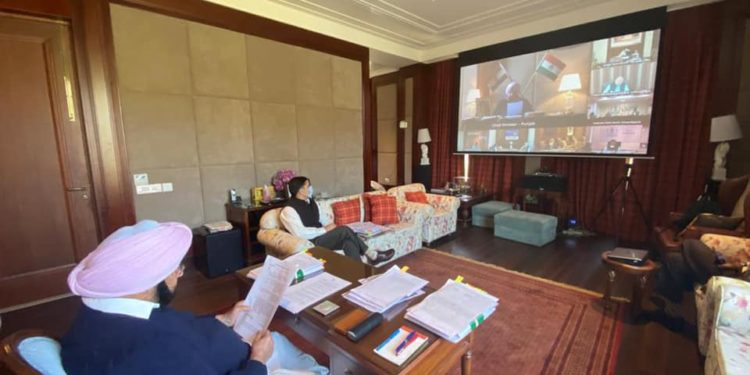SIMPLIFIES PROCEDURES, ENHANCED VALIDITY OF PERMISSIONS, NO AAI NOC ETC. AMONG KEY HIGHLIGHTS
CM DIRECTS STRICT MEASURES TO ENSURE TIMELY RESTORATION OF ROADS & OTHER BREAKAGES BY TELECOM FIRMS
Chandigarh, November 18: With a view to creating robust telecommunication infrastructure with adequate bandwidth to promote Information Technology, e-governance and e-commerce in the state, the Punjab Cabinet on Wednesday approved a set of new guidelines under a single-window policy to replace the existing norms, but with strict directives by Chief Minister Captain Amarinder Singh to ensure timely restoration of roads and other infrastructure damaged by the telecom firms.The new guidelines will supersede the Telecom Policy notified on December 5, 2013 and December 11, 2015, an official spokesperson said after the meeting, adding that the amended policy was aligned to the Right of Way Rules, 2016.This decision would enable speedier permissions for installation of Telecom Towers/Masts/Poles and Right of Way (RoW) Clearances for laying of Optical Fiber Cables etc. to registered Telecom Operators/Infrastructure Providers at Government/Private buildings and lands. Enhanced period for validity of permissions, no NOC requirement from AAI and elimination of NOC requirement from PPCB for installation of generator sets are among the key highlights of the new policy.Listing the salient features of the new guidelines, the spokesperson said the existing fee structure would be rationalised by replacing the various charges currently being collected by the State, in the form of Onetime Fee, Annual User Fee, Sharing Fee and Enhancement in all the charges after every 5 years, with a one-time Administrative Fee of Rs.10000/- per tower. This will help bridge the Digital Divide between the Rural and Urban areas of the State, and provide a well-knit telecommunication Infrastructure network to promote E-Governance, E-Commerce and Information Technology etc.The single-window policy envisages providing online clearances through Punjab Business First Portal in a time-bound fashion, with the provision of deemed clearances built into the new guidelines. The Deputy Commissioner of the concerned District shall be the single contact person for all clearances and shall be responsible for addressing public grievances relating to installation of telecom infrastructure. Under the approved guidelines, the period of state government permissions has been enhanced to 20 years from earlier 10 years and has been made co-terminus with the clearance of the Standing Advisory Committee on Radio Frequency Allocation (SACFA). The new guidelines would dispense away with the requirement of a separate NOC from Airports Authority of India if SACFA clearance has already been obtained by the Telecom Service Providers/Infrastructure Service Providers from Department of Telecommunications, Government of India.With the objective of simplifying the procedures, the requirement of NOC from Punjab Pollution Control Board (PPCB) for installing generator sets of up to 1 MVA Capacity has been dropped on the analogy of instructions of Central Pollution Control Board for setting up of telecommunication towers in the State.It may be recalled that the Punjab government had issued the Telecommunications Infrastructure guidelines for establishment of Telecommunications Infrastructure by Telecom Licensees and Registered Telecom Infrastructure Providers (TSPs/IPs) on December 5, 2013, which was later amended on December 11, 2015. Government of India has advised the various State governments to align their Telecom RoW Policies with the Right of Way Rules 2016 of Government of India. The Industries & Commerce department, with an objective to align Telecom/RoW Policies with the Right of Way Rules 2016, has proposed new Telecom Guidelines superseding the earlier guidelines notified on December 5, 2013 and December 11, 2015. A total of 19 states such as Haryana, Uttar Pradesh, Uttarakhand, Rajasthan, Maharashtra, Madhya Pradesh, Odisha have aligned their policies with the Right of Way Rules, 2016.








